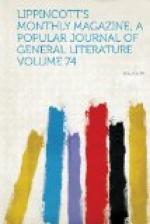In Great Britain the rifle, ancient or modern, like, indeed, any other firearm, has yet to establish itself as a democratic “institution.” Her forests are not forests in our sense, and her mountain-dwellers know little of the rifle. In the duke of Athol’s seventy-mile forest, with scarce a tree save planted larches, the stag roams by thousands, but of course the game-laws interpose, as they did eight hundred years ago, between him and the (biped) hind. He is still the reserved luxury of the Norman. So with the leagues of upland where His Grace of Sutherland has made the Highlander give place to the hart, the “lassie wi’ the lint-white locks” to the Cheviot ewe—where, in short, the white Celt has been improved out of existence as remorselessly as the red man in America, and that in favor not of a superior race of men, but of ferae naturae. Into these and similar districts, at stated seasons, sundry squads of gentlemen are turned loose. They either “pay their shot,” as Punch has it, in the shape of rent, or are the guests of the noble proprietors. Their devices for circumventing the antlered monarch of the waste are amply detailed by Scrope, Hawker, Herbert and also by the late Edwin Landseer doing the pictorial department with a success attributable chiefly to his management of landscape effect, for his dogs, deer and other animals from his AEsop’s fable-like groups to his four duplicated lions in Trafalgar Square, belong—heretic that we are to say it!—properly to still life, their want of action and verve placing them beneath comparison with the works of either one of a score of Flemish and French painters, from Rubens and Snyders down to Bonheur and Vernet. That his unsold pictures have brought, since his death, something like half a million proves nothing. Time was when the worthless canvases of West and Morland were equally transmutable into gold.
Like other forms of British field-sports, deer-stalking is sufficiently intricate and artificial. It is obviously the occupation of men whose primary object is more to kill time than to kill deer. According to print, from type and plate, the stag, a reduced edition of the American wapiti, is, in the heart of a little kingdom of some hundreds of souls to the square mile, as little accustomed to the sight of man and as hard to approach as he would be on the head-waters of the Yellowstone. If five or six hours’ worming, ventre a terre, up the bed of a mountain-torrent, with not even a rowan-bush to aid concealment, succeed in bringing the sports-man within two hundred yards of his unconscious game, it is a good day’s performance. How, the dun deer’s hide once perforated, the “tail” of game-keepers, beaters and volunteer hangers-on is gathered up, the comforting toothfu’ of usquebaugh absorbed by the toilers of the brae, the victim “gralloched” and suspended across the inevitable gray Highland pony that makes such a capital “first light” for the foreground,




